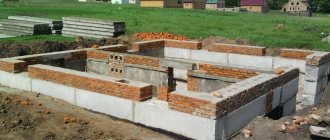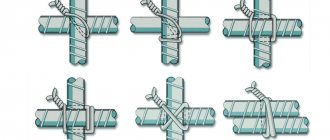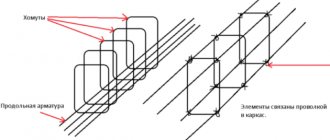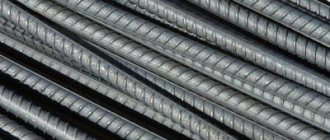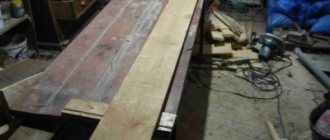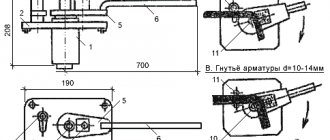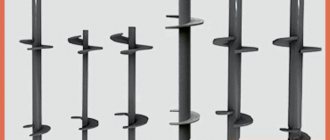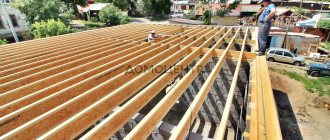Not a single industrial or civil construction project is built without the use of reinforced concrete products and structures. To enhance strength and reliability, concrete is reinforced; a reinforcement frame is placed in its “body”. Knitting wire is the most popular material for connecting metal rods to each other to create a frame; this is what will be discussed in this article.
Application and production technology
Wire for tying reinforcement is most popular in monolithic construction. With the help of concrete and reinforcement, buildings of the most unusual shapes are created, thanks to its technology and the integrity of the structure from the foundation to the roof. It is in this area that more than one object can do without the use of wire.
The wire is used for reinforcement of such reinforced concrete structures as:
- Foundations (strip, slab, pile).
- Walls, columns, beams and lintels.
- Stairs.
- Monolithic floors.
- Floor screeds.
The most important parameters of wire for tying reinforcement are flexibility and strength. It must provide a reliable connection of intersecting reinforcement elements, and at the same time be soft and pliable for quick work.
These characteristics are ensured by the properties of the material, production technology and subsequent heat treatment.
The material for production is low-carbon steel. Wire is a product of the process of drawing a workpiece through dies with a given diameter. Under the influence of pressure and in the process of plastic deformation of the workpiece, the steel structure is refined and improved, and a hardened hardened layer is formed on the surface.
However, after such a procedure, significant internal stresses remain in the metal, which do not allow the resulting product to bend; it will be rigid and brittle. Therefore, in order to be able to use the wire for knitting, it is subjected to heat treatment - annealing. During the annealing process, relaxation and stress relief occur. Thus, the result is a durable, easy-to-use product.
Production of binding wire
The production process includes two stages. First, the steel wire rod is rolled and wired without heating. To do this, the product is passed sequentially through several holes of different diameters. The output is rigid and durable thermally untreated steel wire. After drawing, the product is leveled and galvanized to increase its service life.
The second stage is annealing. At this stage, the wire is heated to 900°C, after which it is allowed to gradually cool. Heat treatment strengthens the metal, improves its structure and relieves internal stress. Heat-treated wire is plastic, does not crack and retains its shape well.
Depending on the environment in which the heat treatment took place, the burned wire is divided into light © and black (B). The light one is annealed in a gas environment, the black one in a gasless environment.
Labeling and classification
All produced knitting wire is manufactured in accordance with GOST – 3282-74 “Low-carbon steel wire for general purpose”. The document regulates all technical characteristics - type, dimensions, manufacturing accuracy, mechanical properties of the material.
GOST specifies the classification of wire according to the following criteria:
- By type of processing - heat-treated or not.
- Depending on the type of coating - with or without galvanized coating.
- In terms of manufacturing accuracy - with increased or normal accuracy.
- According to temporary tensile strength (only for non-annealed) – groups I and II.
Depending on the conditions under which the heat treatment was carried out, the wire can be light or black. Black is obtained by annealing in air; under the influence of oxygen, oxides and scales are formed on the surface of the metal. The light one undergoes heat treatment in an environment of inert gases, its surface is clean, but in terms of technological parameters it is no different from the black one.
Wire can be produced with a diameter from 0.16 to 10 mm without coating, and 0.2 - 6 mm with coating.
A coil of the most popular galvanized binding wire with a diameter of 1.2 mm, weighing 25 kg.
Wire markings include:
- diameter – indicated in millimeters;
- type of treatment – letter O, in case of heat treatment;
- manufacturing accuracy - letter P with increased accuracy;
- surface type – C (light), B (Black)
- presence of zinc coating - 1C or 2C (the number indicates the class).
All produced wire is wound onto coils or spools, undergoes mandatory control, is marked and confirmed with a quality certificate. The products required for use are selected based on the labeling. Each type of knitting “thread” has its own purpose based on the conditions of its use.
Wire Types
Heat-treated low-carbon steel wire is divided into the following types:
- Light (C) – thermally treated in a protective atmosphere.
- Black (B) – covered with scale after the heat treatment process.
- Oxidized – oxidized, with tarnished colors, heat-treated.
Knitting wire GOST 3282, heat-treated (O, annealed) is an indispensable material for the production of nails. It is used for tying cellulose, sets of pipes and circles, and is used for fencing construction sites and land plots. Coated with a protective layer of zinc, it is in enormous demand for the production of chain-link mesh, twisted, woven, masonry and woven mesh. Knitting wire of 1.2 mm, 1.4 mm, 1.6 mm, 2 mm, 6 mm diameters is in very high demand on the hardware market.
What wire is better to knit reinforcement
The main selection criteria are the diameter of the reinforcement and the tool used. For wire knitting, collets are used, as well as manual, semi-automatic and automatic hooks.
Homemade hook for tying reinforcement with wire.
The main task of the wire is to securely fix the reinforcement; the thicker it is, the thicker the connecting element should be. The minimum diameter used for knitting work is 0.8 mm; it is used for tying reinforcement whose diameter does not exceed 10 mm. Sizes from 1 mm to 1.2 mm are most often used in private low-rise construction. And when constructing buildings with significant loads, it is recommended to use 1.4-1.6 mm wire. To perform knitting work, it is enough to use material of normal accuracy.
Advice from the master! I have been engaged in monolithic construction for more than 10 years and I want to say that the most convenient wire for crocheting reinforcement has a diameter of 1.2 mm. Suitable for tying rods of all diameters, just for reinforcement with a diameter of 16 mm and above, take two wires.
Features of choosing knitting wire
Before you buy a knitting wire at a good price, you should decide on its parameters. To do this, first select the diameter of the reinforcement. According to the standards, when using fittings with:
- Ф12mm, use wire with a cross-section of 1.2 mm;
- Ф16 – 18 mm, rolled metal with Ф1.6 mm is used;
- Ф18 mm, it is better to use products with Ф2.0mm.
Before buying knitting wire wholesale in St. Petersburg, calculate its consumption. Therefore, first a drawing of the reinforcement layout is made and the number of joints is determined. The standard determines the consumption for each loop for a connection in the amount of 30 cm. All that remains is to multiply the number of connections and the standard per loop to determine the required amount of material. And by multiplying the price of 1 meter by the amount of material, you get the total cost of knitting wire for each object.
The material is shipped in coils or coils, fully complies with state standards and has all the necessary documents confirming the quality of the material.
Advantage of wire over welding
When comparing welding technology with bonded welding, we note the following advantages of wire connection:
- ease of working with the material - the process of knitting reinforcement is feasible for everyone;
- performing reinforcement directly in the formwork;
- convenient adjustment of the position of the rods - if necessary, you can correct the geometry of the frame by untying several structural elements;
- absence of welded joints - when heated, the metal’s initial characteristics decrease, it becomes weaker, the weld is more susceptible to corrosion;
- affordable price.
The only disadvantages include the unsteadiness of the connected frame, but if you supplement the reinforcing structure with braces, it will become stiffer.
Application of annealed and galvanized wire
“Knitting” without heat treatment is rigid and durable. It cuts well, but does not bend or hold its shape well. It is used for the production of nails, drill springs, chain-link, welded mesh and other metal products. Galvanized knitting wire has low cost and good corrosion resistance. It is used for temporary fastening of wires in electrical work and for fixing individual parts in mechanical engineering. In construction, wire is used for binding and fixing structures made of reinforcement for their subsequent welding.
Annealed wire with a diameter of 1.2 mm is used by builders to tie reinforcement before pouring reinforced concrete blocks. Connecting the reinforcement using a binding wire allows you to quickly and reliably fix the structure and does not require special skills or equipment from the worker. In mechanical engineering, wire is used to fasten and fix parts.
Steel knitting wire GOST 3282-74 is widely used in everyday life. It is used to produce elements of heating systems, fences, garden tools, hooks, paper clips, wires, and is used for decorative purposes for finishing premises. For domestic purposes, galvanizing with a diameter of 2 mm to 4 mm is suitable.
Knitting wire for tying reinforcement
Long products have many positive characteristics. A favorable price combined with high quality and plasticity are the qualities due to which the product has an expanded scope of application. In the construction industry, tying wire is used for the following purposes:
- for the production of nets and wicker fencing;
- for fixing connections of various designs;
- wire for reinforcement.
In the industrial sector, this material is also quite in demand. It is used for the manufacture of cables, various springs, electrodes, etc.
Application of tying wire
Depending on the manufacturing method, the scope of application of this product is determined. For example, thermally untreated wire is used in the manufacture of:
- staples, nails, wicker fencing, etc.;
- for reinforcing electrical wires.
Long products, which undergo heat treatment during manufacturing, are used for the following purposes:
- in the production of woven mesh;
- for tying reinforcement;
- for fastening pipeline reinforcement mesh.
The knitting wire price per kilogram directly depends on the diameter of the material. The smaller the thickness, the higher its cost.
Recommendations for storage and transportation of material
Each batch of wire, packaged in coils or coils, has a note providing complete information about the product and the manufacturer's company. The material can be transported by any means of transport. Long products are stored in covered warehouses.
Our company provides customers with a wide selection of inexpensive knitting wire in Moscow and the region. The cost of the product depends on the volume of the order; wholesalers receive significant discounts. The sale of material is carried out with delivery to the site.
About the features of wire manufacturing
The process of producing wire for fittings is characterized by the complexity of heat treatment technology. The heated wire rod is rolled, then scale is removed from it and pulled through a special machine. This ensures uniform thickness of the finished product.
After the drawing process, the wire is annealed in hot furnaces in order to give it the correct mechanical properties and a uniform internal structure. The process of manufacturing galvanized long metal occurs in a similar way.
Conventional tying wire for reinforcement is the most popular in the building materials market. It is made from flexible low-carbon steel, which has a high level of ductility. Such wire can withstand at least four bends.
